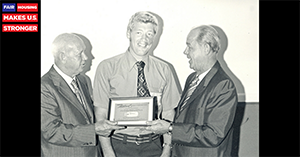Marine Turned REALTOR® Still Fighting for All Americans
By Anthony SanFilippo
When Steve Amos was discharged from the Marines during the Vietnam War in 1968, he didn’t know what he was going to do.
He had grown up in a small town of 100 people in the sand hills of Nebraska but was displaced from his home while looking for work in Omaha. The city was so big. The culture was shocking. But, Amos needed to find a job. A friend named Dick Ellersick had just started his career in real estate. He convinced Amos to work with him on an effort to sell 100 lots for newly developed homes in La Vista, Nebraska.

Steve Amos accepting an award from National Homes for selling 100 fair housing properties circa 1970.
Not knowing anything about real estate, Amos tagged along with Ellersick on a trip to Loghead, Indiana for a tour of the Price Brothers plant. Price Brothers were the innovators of pre-panelized construction in the 1930s. They would build walls at their plant and then put homes up in pre-made sections.
When Ellersick and Amos arrived, there was a big ceremony taking place at the plant. There were a number of guest speakers, including “The Great Conciliator,” former Tennessee senator Howard Baker, Jr.
Baker was speaking about the brand new Fair Housing Act that had just been passed by Congress. But he specifically was talking about a section of the bill that he had co-sponsored – which had been come to be known as the Section 235 Program.
This component of the Fair Housing Act made it so that rather than the federal government dispensing aid to local housing authorities to build public housing, it would instead direct supply-side subsidies to the private sector to stimulate home ownership for minorities and the poor.
“At the beginning it was an incredible opportunity for people who needed homes,” Amos said. “It was $10 down, $109 at closing and 1% interest. It was unheard of.”
Amos immediately sold his first home using the Section 235 Program.
Amos said he started offering this program to more potential buyers, and he and Ellersick had agreements for sales on all 100 lots in the Las Vista development in the span of one month.
But there was a problem.
“We sent each of these potential buyers to see Jack Obdink,” Amos said. “Jack was a survivor of the Bataan Death March during World War II, so he was a no-nonsense guy. He was the local director of the Federal Housing Administration, but his office was completely unprepared to process these Section 235 applications. He told me, in some not-so-flattering terms, that I had to give each of the deposits back.”
Amos did, but Obdink promised he would reach out to Amos once his office was up to snuff on Section 235 processing. But being a military guy himself, Amos knew Obdink would be true to his word – and he was. Obdink reached out a few months later and told Amos his office was finally ready for Section 235 applicants.
Amos and Ellersick eventually found buyers for all 100 properties, but rather than that crush of interested buyers that were there to show interest in buying those homes in less than a month when the Act was first announced, this time it took Amos and Ellersick more than a year to sell all 100 lots.
“It was definitely a hard lesson,” Amos said.
But that initial rush of finding homes for people who couldn’t afford them was a special time for Amos. He made it a point that in his career, he would be a fair housing champion and try to find homes for minorities and the poor as often as he could.
He even went ahead and got licensed in neighboring Iowa so that he could sell in both places. He even moved to Iowa – sort of.
Amos bought a house in Carter Lake, Iowa, but the land sits on the Nebraska side of the body of water. In short, it left Amos in no man’s land.
North Omaha, had a lot of minorities at the time, and while he had no problem convincing sellers to sell their property to minorities, he couldn’t find a bank that would make a loan. They weren’t interested in giving loans to minorities or trusting a real estate agent from Iowa.
And when he tried to sell homes in Iowa, he was told to go back to Nebraska because they didn’t want people like him selling to minorities in Iowa.
“It was a good old boy network in the late 60s and early 70s,” Amos said. “People started to become educated and break through about 10 years after the Fair Housing Act, and eventually things started to get better, but for that first decade, it was tough.”
Amos said the loan and mortgage bias wasn’t just against minorities and the poor but was also sexist against women.
“If I had a single white guy who wanted to get a loan, it wasn’t a problem,” he said. “But if I tried to get a single woman a loan? They would deny her almost immediately. Women, minorities, the poor – they were all being redlined. When I reminded the banks about the Fair Housing Act, they would just laugh at me and say, ‘We don’t care.’
“A lot of people in the industry were like me, and when they ran into these obstacles, they just quit the business. But I stuck with it. I wanted to make a difference. And eventually, I was able to make a good career out of it, start a family and be successful.”
Amos is still selling homes today. He said Nebraska and Iowa have come a long way in the past 50 years.
“When you get away from discrimination and treat everyone fairly, that’s the golden rule for REALTORS®.”
“When you apply the education with it, and it has completely changed the industry from where we were as recently as 40 years ago. You can lose your license now for doing the wrong thing. I believe in the good of people and there is good in all of us. As REALTORS® The Fair Housing Act allows us to find that good, expand it and make it ingrained into our communities.”
Source: https://homeownershipmatters.realtor

